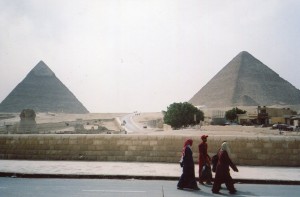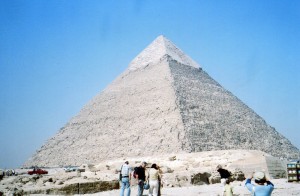King Khufu’s Great Pyramid at Giza first stood alone. Imagine its glory as it rose 481 feet from a cliff that presided over the Nile and the royal city of Memphis, within sight of Heliopolis, where the sun cult was centered. And then–
Khufu’s son Khafre erected his pyramid next to it. No two buildings have better complemented each other. Let’s explore the son’s work.
We’ll start with some basic facts in this post:
1. Khufu had an older son, Djedefre, who first became the Pharaoh. He built his pyramid about 5 miles north, at Abu Roash. It was closer to the sun cult’s center at Heliopolis.
2. Khafre then succeeded his older brother, and he moved his burial site back to Giza.
3. The ground Khafre decided to build his pyramid on was sloped, and his builders had to level it. They cut the northwest corner down by 33 feet, and built up the opposite corner with large stone blocks.
4. Khafre’s pyramid is a little shorter than Khufu’s. But the ground Khafre built his on is 33 feet higher, so its apex is a little higher than his father’s.
5. Khafre’s pyramid is a little steeper than Khufu’s. It rises at a 53 degree angle. This is nearly the same angle that the builders of the Bent Pyramid attempted before their big whoops.
6. But the top is a little twisted. Khafre’s builders didn’t quite properly align the four corners to meet at the apex. Pyramid building was still trial-and-error, and not an exact science.
7. The diagonals of both pyramids are aligned to point to Heliopolis.
These are some surface-level facts about Khafre’s pyramid. But if you’ve read a few posts in this blog by now, you know we get much deeper than the surface. Like the Great Pyramid complex, the whole system of several buildings is much more interesting than the single pyramid. The other buildings that Khafre erected influenced ancient Egypt for the rest of her history. We’ll explore them in Part Two, The Great Sphinx.



Comments on this entry are closed.